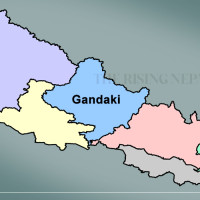- Thursday, 25 December 2025
Dry spell, wild fires worsening air pollution
Kathmandu, Feb. 19: Nepal has been consistently ranked among the top 10 most polluted countries, with the Kathmandu Valley being a major hotspot.
The lack of rainfall, forest fires, waste burning and burning of agricultural residues are the major causes of the high pollution level in the country, experts said. The Kathmandu Valley is affected worst because its bowl-shaped topography contributes to the accumulation of pollutants, as it restricts air circulation, they said.
On Tuesday afternoon, the Air Quality Index (AQI) readings across various locations in Nepal were as follows -- Bhaisepati recorded an alarming 516, Birendra School in Bhaktapur measured 154, the U.S. Embassy recorded 172, Shankapark 164, Hetauda 152 and Bharatpur 154.
Water pollution, a major concern during the winter season, has worsened due to the lack of rainfall. This year, Nepal has received only 5.7 mm of rainfall, just 9.5 per cent of the seasonal average of 60 mm, indicating severe drought conditions in the country.
According to environmentalist Bhusan Tuladhar, at the beginning of the winter season, there was minimal external pollution. However, Nepal is now experiencing pollution from bordering countries as well.
“Winter tends to trap pollution more than other seasons and the lack of rainfall has worsened the situation. Various sources, including forest fires, vehicle emissions, open burning and brick kilns, are contributing to rising pollution levels, especially in Kathmandu. Other Tarai districts are also facing similar challenges,” he said.
Fire incidents are on the rise as the winter drought worsens. Smoke from forest fires is a major contributor to winter pollution and the valley traps much of this smoke due to its geographical structure.
“We can control forest fires by creating forest lines and collecting forest residue for biomass production. Most of these fires are caused by humans, and we can prevent them by educating people about the risks of smoke and fire,” Tuladhar said.
The government has formulated an “Air Quality Management Action Plan for Kathmandu Valley 2017” and there are 176 activities.
The Air Quality Management Action Plan for Kathmandu Valley outlines 176 activities aimed at improving air quality. Some of the key elements include -- upgrading vehicle emission standards to Euro-IV to reduce pollutants from automobiles, setting up at least five centres to ensure vehicles meet emission and safety standards and developing a national programme and financing mechanisms to encourage the use of electric vehicles.
Similarly, other elements include implementing strict emission standards for industries, including brick kilns, to minimise air pollution, encouraging industries to adopt environmentally friendly technologies and fuels, mandating the use of dust suppressants and barriers at construction sites to reduce particulate matter and promoting the creation and maintenance of parks and green belts to improve air quality.
In the solid waste management sector, the plan is to ensure segregation, collection and disposal to prevent open burning, encourage practices that reduce waste and associated emissions, educate citizens about the causes and health impacts of air pollution and ways to reduce personal contribution and enhancing the skills of officials responsible for implementing air quality regulations.
Tuladhar stressed that the five-year plan needs to be revised, implemented and regularly updated. He said that certain aspects, such as fire control, should be included in the plan. “We can reduce pollution levels to some extent if every municipality works together to test vehicle emissions, particularly for diesel-run vehicles. Similarly, truck owners and operators should be provided with training to raise awareness and help them contribute to controlling pollution,” he said.
The plan currently focuses only on the Kathmandu Valley, but pollution is increasing in the Tarai areas as well. Therefore, it should be expanded nationwide and implemented effectively.
The Department of Environment also issued a public notice urging people not to burn waste, to maintain vehicles regularly, to use clean energy in industries and kitchens and to help control smoke and dust on the roads.
















